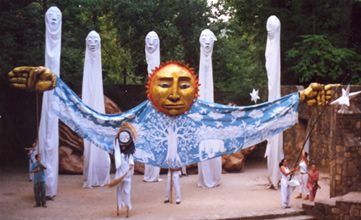The North Carolina Wind Orchestra is our region’s only professional ensemble of its type. There’s a parallel group that is in some ways comparable; the Triangle Brass Band is also of professional quality. The ranks of both ensembles are populated with professional artists and teachers with vast experience. It’s a pleasure to report that the members of both groups seem to love what they do – and their delight shows not only in their playing, which is crisp and precise and well-blended as any regional orchestra (and a good deal better than some), but also in their body language – these folks really dig into their work.
For bands as well as orchestras, Raleigh’s Meymandi Concert Hall is a splendid venue wherein even the loudest fortissimi don’t ever beat listeners over the head, as smaller rooms with poorer acoustics often do. It was there, on May 13, before a pitifully small audience, that Michael Votta, Jr. (who also leads the aforementioned TBB), directed the NCWO in its spring concert, a program titled “Dances of Love and War.” The music was richly varied and magnificently rendered. There were some tunes a few listeners might have known, or thought they knew, but there were also some new things that delighted those in attendance.
The program got underway with a vengeance, with the “War Dance” from Respighi’s ballet Belkis, Queen of Sheba. It was played in an arrangement for band by the director himself. Now Respighi is known for some pretty bombastic stuff, including Feste romane, but this little ditty tops even that orchestral showpiece in its vehemence and dynamic level. It’s brash and loud to the point of noisy, and there’s not much of a tune, but the tune there is is given out often enough that no one’s likely to forget it – after hearing it in a quasi-fife-and-drum version and then repeatedly (and, as someone said, ad nauseam), in other instrumental combos and by the whole shebang for the duration – the last phrase suggesting, intentionally, long-term combat. It’s short. That’s good. And no one slept through it. Ah! The delights of music!
It was a relief when the NCWO turned to Grainger’s calmer, more soothing “Colonial Song,” written to remind his mother of home, in Australia. Its harp lines and accents – played by guest artist Emily Laurance – and its overall shape and mood remind one of the composer’s immensely popular folksong arrangements and other works that sound like folksongs, and it ends with a blissfully serene dying-away coda.
The evening’s big work was a suite called Terpsichore by Bob Margolis, after Praetorius (and others). Votta’s excellent program notes state that the music is based on (or drawn from) dances from the Court of Henry IV of France. The four-movement suite contains subparts that contrast admirably. The overall effect – ironically, given the opening work – suggests the comparably brilliant and effective arrangements of dances and “ancient airs” by Respighi, who was one of the 20th century’s great orchestrators. Based on Terpsichore, I’d say Margolis fits that category, too. The performance itself was brilliant, too, and during it there were numerous brilliant contributions from the many master artists of the ensemble, whose ranks include more than a few souls whose names would be recognized by area orchestral enthusiasts and chamber music fans. (To cite just one, there’s Michael Stephenson, of the New Century Saxophone Quartet, who apparently comes up to the Triangle regularly, from his home in Greenville, to play with the NCWO!) This music was one of the season’s most felicitous discoveries, for this listener, so here’s hoping we’ll hear it again ‘ere long. (For more information on Margolis, see the third item at http://www.ckcb.org/gpage6.html [inactive 9/07]; and for more info on Terpsichore, including a downloadable MP3 recording, see http://manhattanbeachmusiconline.com/manhattan_beach_music/html/terpsichore2.html [inactive 2/07].)
Part II of the concert began with another rarity – the Scherzo from Bernstein’s Jeremiah Symphony, a work known to most music lovers only from recordings (if they know it at all). It speaks in liturgical overtones but there’s lots of the great master we’ve come to love so much in the music and, like the evening’s other works, it was beautifully played. So, too, was an arrangement of Morten Lauridsen’s great choral work, “O Magnum Mysterium,” which CVNCers have commented on in other settings. Votta stated that this is “the most beautiful piece of music I have run into in my career,” and he led a performance of exceptional merit that sounded as if it came directly from the conductor’s and the players’ hearts. It doesn’t get any better than this – not with the world’s most acclaimed artists and ensembles – and this is here!
The finale was the “Star Wars Trilogy” of John Williams, given in Donald Hunsberger’s arrangement. The four-part(!) compilation recaps many familiar tunes, but the playing was so incisive and intense it seemed as if we were hearing the music for the very first time. ‘Twas an impressive evening with an ensemble that is one of our regional treasures.
Note: The program’s “greeting,” from President Robin Gorham revealed aspects of the NCWO’s work that many readers may not know. They send educational packets – recordings and notes on the music – to area band directors in advance of their performances; these go to a dozen schools, and students with ID can get into the concerts for $2 – less than the cost of a movie in most theatres. In addition, they’ve enlisted students to sell tickets, in advance – and they give back half of the ticket price to the students’ band programs. As we said, it doesn’t get any better than this! For more information, see http://www.ncwo.org/ [inactive 9/06].











